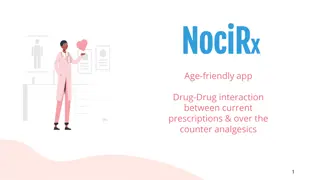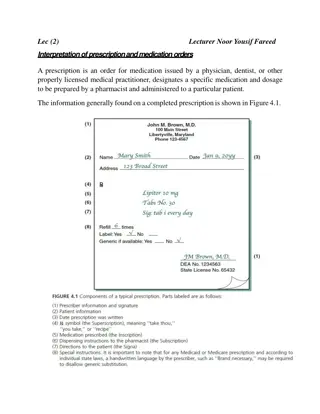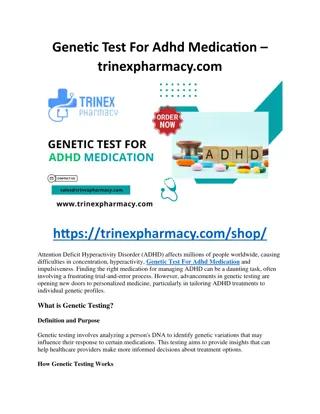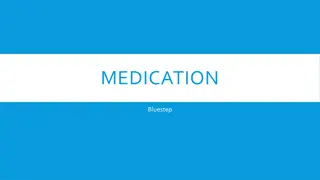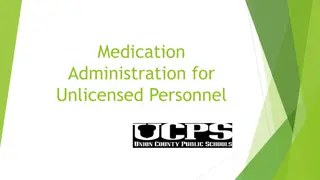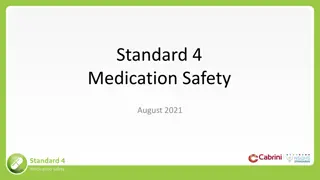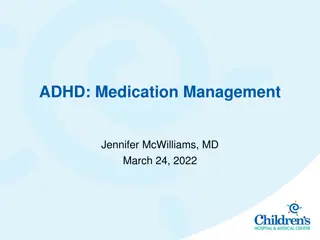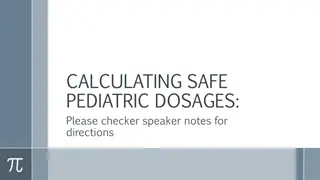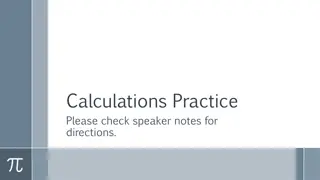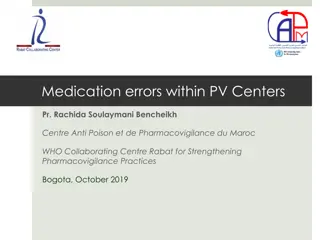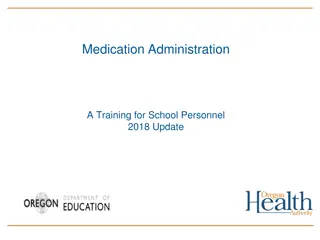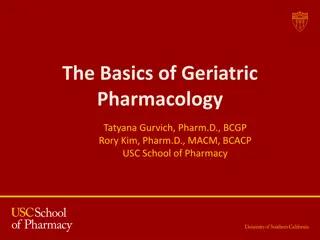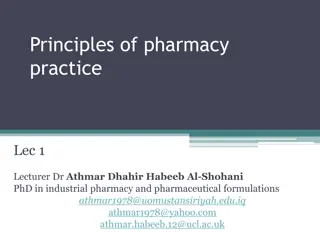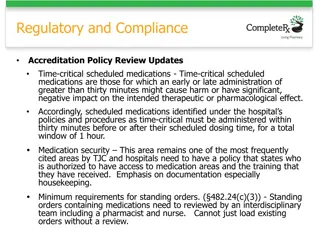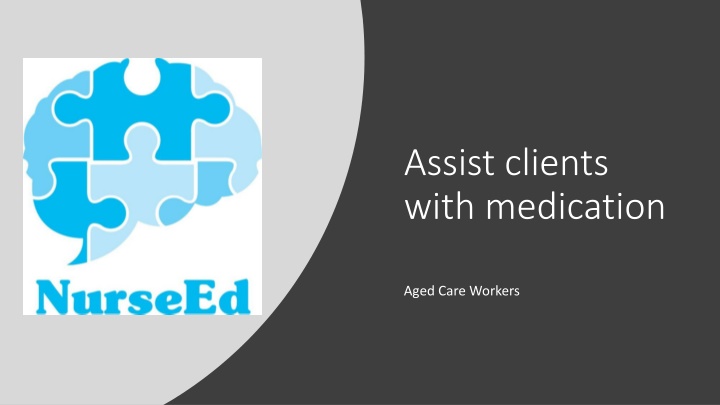
Essential Guide to Medication Management in Aged Care
Discover the key terminology, abbreviations, and legislation relevant to assisting clients with medication in aged care settings. Learn about the importance of proper medication administration to improve health outcomes and ensure the safety of elderly individuals.
Download Presentation

Please find below an Image/Link to download the presentation.
The content on the website is provided AS IS for your information and personal use only. It may not be sold, licensed, or shared on other websites without obtaining consent from the author. If you encounter any issues during the download, it is possible that the publisher has removed the file from their server.
You are allowed to download the files provided on this website for personal or commercial use, subject to the condition that they are used lawfully. All files are the property of their respective owners.
The content on the website is provided AS IS for your information and personal use only. It may not be sold, licensed, or shared on other websites without obtaining consent from the author.
E N D
Presentation Transcript
Assist clients with medication Aged Care Workers
Terminology for this unit
Terminology for this unit
AC = before food. BD = twice daily. Abbreviations for medication administration M or MANE = in the morning. N or NOCTE = at night. D or OD = daily.
PC = after food. PRN = when required. Abbreviations for medication administration cont. QID or QD = four times daily. QQH = every four hours. STAT = immediately. TDS or TID = three times daily.
The appropriate use of medication can treat disease and/or control symptoms and improve the health and comfort of older people. Medication used incorrectly has the potential to cause harm. Introduction Increasing numbers of elderly people in residential care and home care cannot manage their medication and are dependent on health professionals.
Care workers must be aware of the fact they work within Commonwealth and state laws and must follow organisational guidelines: Commonwealth legislation Aged Care Act 1997. State legislation Drugs and Poisons regulations Nursing acts. Workplace guidelines - organisational policies/ procedures. Legislation and organisational guidelines
Drugs and Poisons Acts: control distribution, storage and administration of poisons and drugs govern the production, labelling, sale and use of poisonous substances, dangerous drugs and drugs of addiction define eight separate schedules of drugs and poisons (these schedules are the same in all states) check the state you work in. State Legislation
Know where to access and how to work within the following: organisational policies and procedures manuals medication management administration policies work health and safety guidelines. Workplace policies and procedures
Is a legal term. Describes your duty to work responsibly where it is foreseeable your actions may affect someone else. Duty of care All employees and employers must follow safe work practices. Failing in duty of care is classed as negligence.
To have appropriate medication qualification/training. To know legal and workplace guidelines. A care worker s medication responsibilities To assist or supervise medication as documented. To monitor/document taking of medication. To report/document contingencies. To follow health professional s instructions.
A care worker is accountable to: The supervisor RN in charge Accountability Other health professionals. They must follow health professionals instructions.
Proceed to assist with medication when: you have the legal right to assist the task is within organisational guidelines the documentation is up to date/ checked your preparations have been checked your supervisor has given you the authority to proceed. Authority to assist with medication
Work role of care worker in medication administration A care worker can work with two types of clients in medication administration: Those who self-medicate and require supervision only. Those who require physical assistance with medication
Self-medication means that a person is able, without assistance, to administer medication to themselves according to the directions on the label of the medication. A client must be assessed for self- medication and have a signed approval form. Self-medications must be documented. What is self- medication ?
Discussing medication process. Confirming type and time of medication. Establishing what support is needed. Assisting with posture/position. Assisting to open/measure medication. Ensuring fluids are available. Providing privacy. Physical assistance for clients taking medication
Forms of medication
Forms of medication
Dose Administration Aids (DAAs) DAAs are blister packs filled by pharmacy, usually containing a week s supply of medication. DAAs assist older people who self-administer and take multiple drugs.
Contain lockable cupboards for medication. Can carry DAAs. Have equipment space. Have space for medication charts. Medication Trolleys
Equipment for medication trolleys
A medication chart is a comprehensive form that contains all information related to medication management, such as: client s details all medication details and procedures doctor s signature. After medication, the chart is signed. Medication chart
Drugs have : a chemical name a generic name a trade name. Understand different medications For example: Acetaminophen = paracetamol = Panadol (chemical) (generic) (trade)
Understand different medications cont.
Understand different medications cont.
Check medication is: within date not contaminated, opened or deteriorated labelled clearly stored correctly. Check medications
Procedures to follow include: greet and identify client wash hands Prepare client to administer medication assist as needed/indicated in notes check authorisation and medication label check medication expiry and cautions explain procedure.
Procedures to follow include: ensure all medication is taken/used Complete administration of medication discard waste wash hands document, date, time and sign leave client comfortable.
Oral solid from container. Oral solid from blister pack. Oral liquid from bottle. Different forms of medication for administration Ear drops (ear, eye, nose). Ointment, cream. Spray. Inhalant (nebuliser, aerosol). Transdermal patch.
Different types of medication
Report any observed changes in clients to health professional: before medication Report changes in client during medication after medication.
Report changes in clients condition using sight, hearing, touch and smell: colour (flushed, pale, rashes) expression (in pain) Observation skills tone of voice (stressed, in pain) breathing difficulties (wheezing) coughing temperature (hot, cold to touch)
skin (moist, clammy) pulse (weak or racing) swelling Observation skills cont. smell of urine/faeces poor balance (dizzy) hyperactive/lethargic.
1. Right patient. Check the name on the order and the patient. ... 2. Right medication. Check the medication label. ... Eight rights of medication administration 3. Right dose. Check the order. ... 4. Right route. Again, check the order and appropriateness of the route ordered. ... 5. Right time. ... 6. Right documentation. ... 7. Right reason. ... 8. Right response.
Client checks: ask the client for their name check the client s photo ask a family member to identify the client if unsure if still in doubt, check with your supervisor. 1. The right person
Medication checks: it has been authorised by a doctor it has been written in the medication chart it is labelled correctly you recognise it. 2. The right medication
Check if the medication: is in a DAA has the dose on the medication chart/ medication label is taken whole or divided is to be crushed has been measured at eye level label is clear. 3. The right dose
Medication can be: oral absorbed via intestines or stomach injection to blood stream, muscle or under skin inhalation breathed in insertion vaginal and rectal instillation ears, eyes, nose topical on skin sublingual under tongue. 4. The right route
Check: the time of day for administration special instructions, such as before/ after meals, at night, morning. with or without food 5. The right time
Document administration AFTER giving the ordered medication. Chart the time, route, and any other specific information as necessary. For example, the site of an injection or any laboratory value or vital sign that needed to be checked before giving the drug. 6. Right documentation
Confirm the rationale for the ordered medication. What is the patient s history? Why is he/she taking this medication? Revisit the reasons for long-term medication use. 7. Right reason
Make sure that the drug led to the desired effect. If an antihypertensive was given, has his/her blood pressure improved? Does the patient verbalize improvement in depression while on an antidepressant? Be sure to document your monitoring of the patient and any other care interventions that are applicable. 8. Response
document the ingestion/ completion of medication report facts/ observations record inconsistencies/ contingencies report concisely and clearly record refusals record times and dates sign/ initial documentation avoid jargon Write it down fill in incident report for errors use acceptable abbreviations write legibly cross out mistakes and initial.
Record any medication issues/errors in: an incident report medical chart progress notes medication record adverse drug incident report. Contingencies recording
Includes: inability to swallow tablet/capsule ejection of medication (coughed it back, spat it out) vomiting spilling/dropping medication refusal. Incomplete ingestion
Issues may include: clients having the right to refuse medication you cannot force a client to take medication you can try to find out the reason for refusal Medication refusal
inform health professional and document refusal client must be informed of possible results of not taking the medication follow health professional s instructions. Medication refusal cont.
Report any changes in clients condition: immediately to your supervisor document according to your organisation s policies and procedures obtain instructions from health professional on follow-up procedures. Changes in client s condition
Changes to airway (e.g. choking). Changes to breathing (wheezing). Changes in person s colour or skin tone, appearance of a rash. Changes to circulation (drowsiness, loss of consciousness). Inflammation or swelling. Headache. Dizziness or confusion. Slurring of speech. Nausea and vomiting. Changes in client s condition
You must always: report any error to your supervisor or health professional immediately document in progress notes of clients and on a medication incident form and/or adverse drug reaction following organisational procedures follow instructions from health professional. Medication errors

